Each angle of a right-angled triangle has a constant ratio called the tangent.
Angle Notation
ABC⇒ The angle at point B.
BAC⇒ The angle at point A.
Or just ∠B, B^ or ∠A, A^
Lowercase greek letters are also commonly used to denote angles:
| α |
alpha |
| β |
beta |
| θ |
theta |
| ϕ |
phi |
Tangent Function
The tangent function of an angle is equal to the ratio of the angle's opposite and adjacent sides.
Given θ°=BAC and ϕ°=ABC
Applicable angles are either of the two angles that are not 90°.
So
tanθ°=bh
tanϕ°=hb
Inverse Tangent Function
The tangent function's inverse calculates an angle based on a known ratio.
tan−1bh=θ°
Facts
All angles of a right-angled triangle always sum up to 180°. Since the right-angle is always one of 90°, the remaining angles always add up to another 90°. Therefore:
90°−θ°=ϕ° and
90°−ϕ°=θ°
tan45°=1
tan90°=invalid
The angle being worked on is called the angle of focus. That angle's tangent ratio is always adjacentopposite
Sine and Cosine Functions
sinθ°=hypotenuseopposite
cosθ°=hypotenuseadjacent
The inverse functions sin−1 and cos−1 yield the angle given a ratio.
Non-right-angled Triangles
Any angle with a perpendicular opposite can be found by bisecting the opposite at that angle by creating two right-angled triangles.
Pythagorean Identity and Theorem
cos2θ+sin2θ=1
a2+b2=c2 where a and b are equal to the lengths of the adjacent and opposite, and c is equal to the length of the hypotenuse.
Relationship of the Functions
Since sinθ°=y, and
cosθ°=x, and
tanθ°=xy, it follows that:
tanθ°=cosθ°sinθ°

